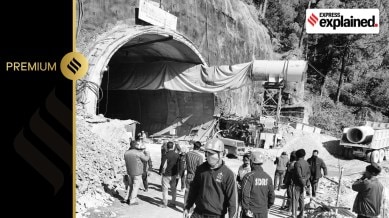Expert Explains: What led to the Uttarakhand tunnel collapse — and how it could have been avoided
An under-construction tunnel on the Yamunotri National Highway in Uttarakhand’s Uttarkashi district collapsed at dawn on Sunday, trapping 40 workers inside.

An under-construction tunnel on the Yamunotri National Highway in Uttarakhand’s Uttarkashi district collapsed at dawn on Sunday, trapping 40 workers inside. While an official report is awaited, Manoj Garnayak, a former project director at L&T and an expert in underground construction, explains how it could have happened — and how it could have been prevented.
What could have caused a part of the tunnel to cave in?
Another reason could be the seepage of water through a loose patch. Water erodes loose rock particles over time, creating a void on the top of the tunnel, which can’t be seen. However, these are only general principles, and we must wait for the results of a comprehensive investigation in this case.
What are the ways in which tunnels are excavated in rock?
There are essentially two ways: the drill and blast method (DBM), and by using tunnel-boring machines (TBMs).
DBM involves drilling holes into the rock and loading them with explosives. When the explosives are detonated, the rock breaks apart.
Building a tunnel with a TBM is more expensive than DBM, but much safer. TBMs bore the rock from the front (using a rotating head) while supporting the excavating tunnel behind the machine by installing precast concrete segments.
In India, imported TBMs are used. Each of these machines can cost up to Rs 200 crore.
Does the method of excavation depend on the type of terrain?
A TBM can’t be used to drill through very tall mountains. Creating a void through a 1,000-2,000-metre-high mountain by using a TBM leads to rock burst — when a part of the rock suddenly falls due to high stress.
TBMs are ideal when the rock cover is up to 400 metres tall. Underground tunnels for the Delhi Metro were dug using a TBM at shallow depth. On the other hand, in places like Himalays, including Jammu & Kashmir and Uttarakhand, DBM is usually used.
Is the Himalayan region too fragile to tunnel through?
Geologically speaking, the Himalayas are still young (they were formed between 40 million and 50 million years ago) and they are still growing due to the collision between the Indian tectonic plate and the Eurasian tectonic plate.
There are some patches where the rock is indeed too fragile for a tunnel. But at other places, the rock is very good.
I have worked in the Himalayan region and built tunnels without facing major issues. We witnessed very small failures, which were rectified immediately by fixing the crown of the tunnel. So, even though in some places the rock is fractured or fragile, there are technical solutions to fix it.
Also, tunnels do not destroy the ecology of the mountain or hill. Tunnel-building technology is around 200 years old and, if executed properly, tunnels aren’t dangerous.
What is the key aspect of building a tunnel?
The first and foremost thing is to thoroughly investigate the rock through which a tunnel is proposed to be made. This is done by sending seismic refraction waves through the rock to check which patches are fragile or solid.
In India, engineers dig a borehole into the rock to extract a core sample, and send it for petrographic analysis (microscopic examination to determine the mineral content, grain size, texture and other features that have a bearing on the mechanical behaviour of the sample).
Such investigations help determine if the rock can take the load of the overburden when a tunnel is created. If the rock layer and its strength are good, it takes the entire load of the overburden by redistribution of the stresses, and it remains stable.
What does it take to construct a stable tunnel?
First, even after excavation and providing support for the tunnel, we need to monitor the spot. It’s essential to check how the rock is behaving at various places. Monitoring is done by instruments such as stress meters and deformations meters.
Then, the supports provided to the tunnel need to be tested for adequacy. Supports can be of various types, including shotcrete (sprayed concrete that works as a membrane to prevent parts of the rock from falling), rock bolt (a long anchor bolt for stabilising rock excavations), steel ribs or beams, and tunnel pipe umbrella, built by using steel tubes that can hold really fragile rocks.
It is also important that an independent specialist geologist visits the tunnel for examination and to check for probable failures. They will also determine the rock’s stand-up time — the duration for which a rock can remain stable without any support. Support is given to the rock within its stand-up time.
Most importantly, in India, more time needs to be spent on studies before starting the construction. Currently, design and construction of a tunnel project is done simultaneously.